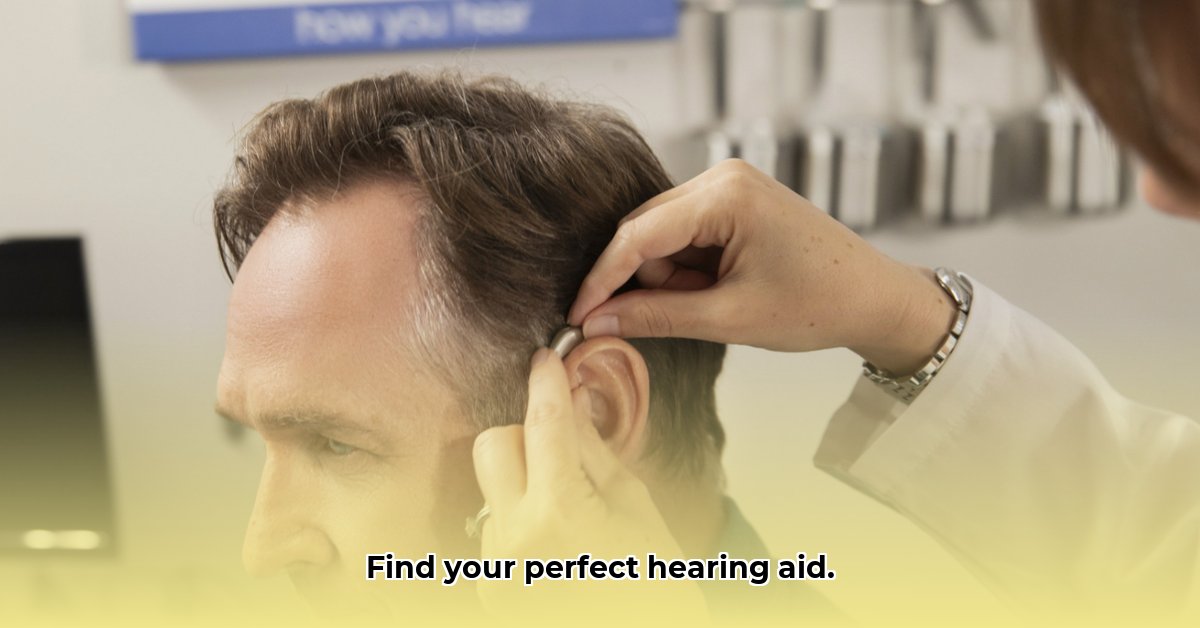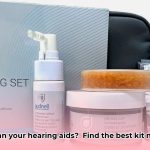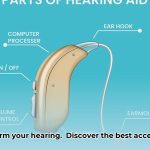Dealing with hearing loss can be tough, but getting the right help doesn’t have to be confusing. This guide will walk you through everything you need to know about getting hearing aids, from understanding your hearing problem to choosing the best devices and making sure they work perfectly. We’ll explain the different types of hearing loss, the tests used to diagnose it, and the various hearing aid options available, including the latest technology. We’ll also cover the professional fitting process, how to adjust to your new hearing aids, and how to solve common problems. We’ll even explore cutting-edge technology that promises even better hearing. Remember to keep your hearing aids clean with a good cleaning kit! Let’s work together to get you back to enjoying clearer sound.
Hearing Aid Fitting: Your Journey to Better Hearing
Hearing loss can be frustrating, making everyday conversations and enjoying life’s sounds a challenge. But the good news is, modern hearing aids can significantly improve your hearing and quality of life. The key? A proper hearing aid fitting. Let’s explore this journey step-by-step and find the perfect hearing solution.
Understanding Your Hearing Loss: The First Step to Great Hearing
Before getting a hearing aid, it’s crucial to understand the type and extent of your hearing loss. Imagine your hearing as a finely tuned instrument; if some strings are out of tune, you need to know which ones and how much to adjust them. This is where an audiological evaluation comes in. It’s a comprehensive checkup for your ears conducted by a licensed audiologist. Why is it vital to determine the precise cause of hearing loss before proceeding? The answer lies in the ability to tailor the hearing aid selection and programming to your specific needs.
Different types of hearing loss exist, affecting different sound frequencies (highs, mids, lows). Sensorineural hearing loss, often caused by damage to the inner ear or auditory nerve, is the most common type and frequently results from aging or noise exposure. Conductive hearing loss, on the other hand, occurs when sound waves are blocked from reaching the inner ear, often due to earwax buildup, fluid, or other obstructions. Mixed hearing loss is a combination of both. Some people experience a gradual, age-related decline (presbycusis), while others have sudden, more significant hearing loss due to illness, genetics, or injury. An audiologist will use a variety of tests, such as pure-tone audiometry (checking your threshold for various pitches), speech audiometry (measuring your ability to understand speech), tympanometry (assessing the function of the eardrum), and otoacoustic emissions (OAEs) to evaluate the inner ear’s response to sound. The results pinpoint the specifics of your hearing loss – its severity, the frequency ranges affected, and the overall profile of your hearing ability.
This detailed picture is absolutely essential. It’s the blueprint for your personalized hearing solution. Without a thorough understanding of your hearing loss, selecting and fitting a hearing aid effectively is nearly impossible; it’s akin to building a house without proper architectural plans. Moreover, identifying the cause of hearing loss can sometimes lead to medical interventions that address the underlying issue, either alone or in conjunction with hearing aids.
Choosing the Right Hearing Aid: Finding Your Perfect Sound Solution
Once you understand your hearing loss, it’s time to select a hearing aid. The market offers a wide variety of options, each designed for different needs and lifestyles; it’s not a one-size-fits-all situation. What factors should be considered when selecting the appropriate hearing aid technology? Consider the degree of your hearing loss, your lifestyle, dexterity, budget, and aesthetic preferences.
Here’s a quick look at common types:
| Hearing Aid Type | Description | Pros | Cons |
|---|---|---|---|
| Behind-the-Ear (BTE) | Larger device worn behind the ear, connected via a tube to an earmold or dome in the ear canal | Durable, powerful, good for various hearing losses, versatile, often longer battery life | More visible than other types, can be susceptible to wind noise |
| Receiver-in-Canal (RIC) | A type of BTE where the receiver (speaker) sits in the ear canal instead of in the body of the hearing aid behind the ear. | Discreet, comfortable, natural sound quality, reduced occlusion effect | Less powerful than traditional BTEs, may require more maintenance |
| In-the-Ear (ITE) | Custom-fit to fill the outer ear | Comfortable, fairly discreet, easy to handle | Less durable than BTEs, may be difficult to adjust for those with dexterity issues, shorter battery life than BTEs |
| In-the-Canal (ITC) | Smaller than ITE, fits partially or entirely within the ear canal | Very discreet, comfortable | Less powerful than BTEs or ITEs, more easily damaged by earwax, smaller batteries require more frequent changing |
| Completely-in-Canal (CIC) | Tiny device entirely invisible (or nearly so) within the ear canal | Extremely discreet, utilizes the natural acoustics of the ear | Difficult to handle, less powerful, easily lost or damaged, shortest battery life, not suitable for all ear canal shapes or hearing losses |
Beyond the type, consider features like Bluetooth connectivity (for seamless streaming from your phone, TV, or other devices), noise reduction technology (to minimize background sounds and improve speech clarity in noisy environments), directional microphones (to focus on sounds in front of you), telecoils (for improved hearing in public places with hearing loops), and rechargeable batteries (for convenience and reduced battery costs). Your budget will also play a role; hearing aids range in price significantly. Remember that investing in a higher-quality device might offer better sound quality, more advanced features, greater durability, and better customer support. Does investing in a higher-quality device result in better sound quality? Generally, yes. Higher-end models often utilize more sophisticated sound processing algorithms and better components.
Should you consider over-the-counter (OTC) hearing aids? These are available without a prescription and might seem appealing because of convenience and cost. However, many audiologists strongly suggest a professional fitting, especially for moderate to severe hearing loss. While OTC devices can offer some improvement for mild hearing loss, a professional fitting ensures the device is correctly matched to your specific hearing loss, resulting in optimal performance, comfort, and long-term success. A professional can also counsel you on realistic expectations and provide ongoing support. Furthermore, an audiologist can rule out underlying medical conditions that may be contributing to your hearing loss.
The Professional Fitting Process: Precision and Personalization for Enhanced Hearing
A professional hearing aid fitting is a meticulously crafted process, not just a simple “plug and play” scenario. It goes far beyond simply placing a device in your ear. Think of it like getting custom-made eyeglasses: a one-size-fits-all approach would be ineffective. Real-ear measurements are a critical part of the fitting process. This verification process ensures appropriate amplification across frequencies.
Here’s what you can anticipate:
- Comprehensive Hearing Evaluation: This is revisited to confirm the specifics of your hearing loss and to account for any changes since the initial evaluation.
- Hearing Aid Selection: Working together with your audiologist, select the best hearing aid to meet your specific needs and preferences. This includes considering style, features, and budget.
- Real-Ear Measurements (REM): Also known as probe microphone measurements. A tiny microphone is placed in your ear canal near the eardrum. The audiologist then plays sounds and measures the actual sound levels reaching your eardrum with the hearing aid in place. This advanced technology ensures that the sound output of your hearing aid matches your unique hearing loss profile. This step is crucial for achieving the best possible hearing outcome and for preventing over-amplification, which can be damaging.
- Programming and Fine-Tuning: Your audiologist programs your hearing aid precisely to your specific audiogram (a graph that shows the results of your hearing test). Think of this as the calibration process. Fine-tuning involves adjusting various parameters, such as gain (amplification), compression (how loud sounds are processed), and frequency response (how different frequencies are amplified), to optimize sound quality and clarity for different listening environments. Often, adjustments are necessary for optimal performance and comfort.
- Counseling and Education: The audiologist will provide detailed instructions on how to insert and remove the hearing aids, how to clean and maintain them, how to change the batteries, and how to adjust the volume and programs. They will also discuss realistic expectations and strategies for adapting to your new hearing aids.
- Follow-up Appointments: These are essential. Your hearing may change over time; these visits allow further adjustments and addressing any issues that may arise. The audiologist will also check the health of your ear canal and make sure the hearing aids are still fitting properly. Regular follow-ups are key to long-term success.
Remember, this is not a one-time appointment. Ongoing adjustments are often necessary for optimal hearing aid functionality. Your audiologist will guide you on this journey. What is one of the most important steps in the professional fitting process? Real-ear measurements are undoubtedly one of the most crucial steps, as they ensure that the amplification is accurate and personalized.
Adapting to Your Hearing Aids
- Achieve Anesthesiology Work-Life Balance: Your Guide - December 4, 2025
- Unlock Young Doctors’ Work-Life Balance: Actionable Strategies Now - December 2, 2025
- Unlock Life Harmony: Work-Life Integration Guide - November 30, 2025
















